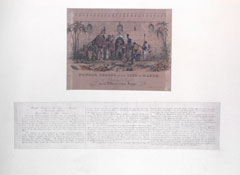
Online Collection
« Prev - 1 of 1 results - Next »
'Bengal Troops on the Line of March - the advanced guard driving in an outpost of the Enemy', 1830 (c)
Colour lithograph panorama in 11 parts after Captain W A Ludlow, 12th Bengal Native Infantry, 1830 (c).
Shows Bengal troops in pursuit of Pindari raiders during the Pindari campaign of 1817-1818.
The Pindaris were mounted raiders from central India. Enjoying the protection of the powerful Maratha chiefs, during the early 19th century, the Pindaris launched devastating raids against unprotected towns and villages from their remote bases in the wilderness. These raids were contributing to a general breakdown of order across the region and brought them into conflict the British East India Company, which was rapidly becoming the dominant power in India. Lord Hastings, the British Governor General, bemoaned how 'millions…. have long been writhing under the scourge of predatory powers as well as under ferocious cruelty of the Pindaris' and resolved to destroy them. To do so, in 1817 Hastings assembled a force of 120,000 troops to sweep across an area of approximately 150,000 square miles from north and south. This campaign brought the British into conflict with the Marathas, with whom they had already fought two major wars. It was further complicated by problems of supply and communication that resulted from the difficult terrain and from the unwieldy composition of the British columns which, as this illustration reveals, included many camp followers, as well as elephants, camels, bullocks, mules and pack ponies. Despite the difficulties, the operation ended in complete success.
NAM Accession Number
NAM. 1950-12-2-1
Copyright/Ownership
National Army Museum, Out of Copyright
Location
National Army Museum, Study Collection
Object URL
https://collection.nam.ac.uk/detail.php?acc=1950-12-2-1














